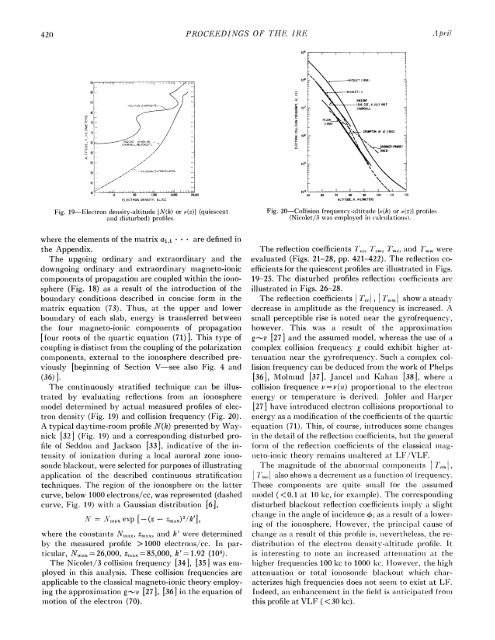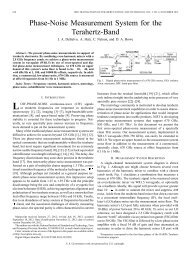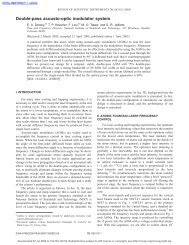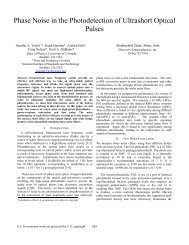Propagation Low-Frequency
Propagation Low-Frequency
Propagation Low-Frequency
Create successful ePaper yourself
Turn your PDF publications into a flip-book with our unique Google optimized e-Paper software.
420<br />
ELECTRON DENSITY, EL/CC<br />
Fig. 19-Electron denisity-altitude [N(h) or V(z)] (quiescent<br />
and disturbed) profiles.<br />
where the elements of the matrix a1,, . . . are defined in<br />
the Appendix.<br />
The upgoing ordinary and extraordinary and the<br />
downgoing ordinary and extraordinary magneto-ionic<br />
components of propagation are coupled within the ionosphere<br />
(Fig. 18) as a result of the introduction of the<br />
boundary conditions described in concise form in the<br />
nmatrix equationi (73). Thus, at the upper and lower<br />
boundary of each slab, energy is transferred between<br />
the four magneto-ionic components of propagationi<br />
[four roots of the quartic equation (71)]. This type of<br />
coupling is distinct from the coupling of the polarization<br />
components, external to the ionosphere described previously<br />
[beginning of Sectioni V-see also Fig. 4 and<br />
(36) ].<br />
The continuously stratified technique can be illustrated<br />
by evaluating reflections from an ionosphere<br />
inodel determined by actual measured profiles of electron<br />
density (Fig. 19) and collision frequency (Fig. 20).<br />
A typical daytime-room profile N(h) presented by Waynick<br />
[32] (Fig. 19) anid a corresponding disturbed profile<br />
of Seddoni and Jackson [33], indicative of the intensity<br />
of ioniization during a local auroral zone ioinosonde<br />
blackout, were selected for purposes of illustrating<br />
application of the described conitiniuous stratification<br />
techniques. The region of the ionosphere oni the latter<br />
curve, below 1000 electrons/cc, was represented (dashed<br />
curve, Fig. 19) with a Gaussian distribution [6],<br />
N = Nniax exp [-(z - zrnax) /k'],<br />
where the constanits N10ax, z.,I,., and k' were determined<br />
bv the measuredl profile > 1000 electronis/cc. In particular,<br />
Nmax 26,000, Zm1a, = 85,000, k' 1.92 (108).<br />
The Nicolet/3 collision frequency [34], [35] was employed<br />
in this analysis. These collision frequencies are<br />
applicable to the classical magneto-ionic theory employinlg<br />
the approximation g-v [27], [36] in the equation of<br />
motion of the electroni (70).<br />
PROCEEDINGS OF THE IRE<br />
(09<br />
NICOLET / 3<br />
^-+@ \ ~~~~~~~~NN3.081'<br />
1216 CST, 4 JULY 1957<br />
st10 7 - \ \ \ CHURCHILL -<br />
z19551<br />
\<br />
CROMPTNu et cl (19531<br />
1l06 -PWE<br />
1\(953)<br />
14 50<br />
I1<br />
60 70 g0 90 100 110 120<br />
ALTITUDE, h, KILOMETERS<br />
Fig. 20 Collisioni frequency-altitude [v(h) or v(z)l profiles<br />
(Nicolet/3 was employed in calculations)).<br />
.11 pril<br />
The reflection coefficients T'EE, 7',0, Tlh,, aiid Twnm were<br />
evaluated (Figs. 21-28, pp. 421-422). The reflection coefficients<br />
for the quiescent profiles are illustrated in Figs.<br />
19-25. The disturbed profiles reflection coefficienits are<br />
illustrated in Figs. 26-28.<br />
The reflection coefficients TC,1Cnj show a steadNy<br />
decrease in amplitude as the frequency is inicreased. A<br />
small perceptible rise is nioted inear the gyrofrequency,<br />
however. This was a result of the approximnationi<br />
g-v [27] and the assumed model, whereas the use of a<br />
complex collision frequency g could exhibit higher attenuation<br />
niear the gyrofrequency. Such a complex collision<br />
frequenicy can be deduced from the work of Phelps<br />
[36], Molmlud [37], Janicel anid Kahani [38], where a<br />
collisioin frequence vP=(u) proportional to the electroni<br />
energy or temperature is derived. Johler aniid Harper<br />
[27] have introduced electroni collisions proportionial to<br />
energy as a modificationi of the coefficients of the quartic<br />
equation (71). This, of course, introduces somiie changes<br />
in the detail of the reflection coefficieints, but the general<br />
formii of the reflection coefficients of the classical ihuagneto-ionic<br />
theory remains unaltered at LF/VLF.<br />
T'he miiagniitude of the abniormiial comiiponenits |en,I<br />
6 also shows a decrement as a funictioni of frequency.<br />
These components are quite small for the assumiied<br />
imiodel ( < 0.1 at 10 kc, for examnple). The correspondintg<br />
disturbed blackout reflection coefficients imply a slight<br />
chatnge in the angle of inicideence Oi as a result of a lowerinig<br />
of the ionosphere. Ilowever, the principal cause of<br />
chanige as a result of this profile is, nievertlheless, the redistribution<br />
of the electron density-altitude profile. It<br />
is iinterestinig to niote an inlcreased aIttellUation at the<br />
higher frequencies 100 kc to 1000 kc. I-lowever, the hiigh<br />
attenuation or total ionosonde blackout which characterizes<br />
high frequencies does iiot seemli to exist at LF.<br />
Indeed, an enhancement in the field is aniticipated from<br />
this profile at VLF ( < 30 kc).





